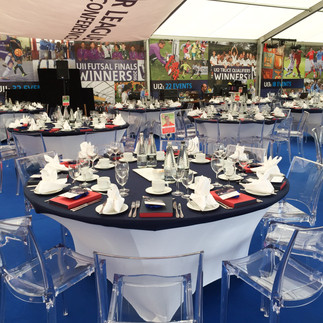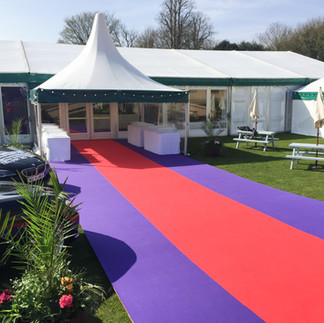10 Essential Tips for Planning a Corporate Event with a Marquee
- Andrea Stephenson-Hemmings
- Apr 8
- 4 min read

Corporate events require careful planning to ensure they are both professional and engaging. Whether you are hosting a product launch, awards ceremony, networking event, or company celebration, hiring a marquee provides a flexible and sophisticated setting. From choosing the right marquee type to managing logistics, here’s your step-by-step guide to planning a corporate event with a marquee.
1. Define Your Event Objectives
Before diving into marquee hire, outline the goals of your event:
What is the purpose of your event? Clearly define whether it’s for networking, training, a product launch, client appreciation, or an internal celebration. The purpose will dictate the overall structure and flow of your event.
Who will be attending? Understanding your audience—whether it's employees, stakeholders, clients, or media—helps shape the event experience, from seating arrangements to entertainment.
What impression do you want to leave? Do you want a formal, corporate look with sleek branding and high-end catering, or a more relaxed and interactive atmosphere? Knowing this will influence everything from marquee design to guest experience.
2. Choose the Right Marquee Type
Selecting the right marquee ensures your event looks professional and functions smoothly. Consider these options:
Clear Span Frame Marquees: These are ideal for corporate events as they offer unobstructed space, perfect for presentations, networking areas, and exhibitions. These provide the most flexibility, as they can be installed on different surfaces and have no internal poles, making them ideal for large conferences and trade shows.
Pagoda Marquees: With their stylish peaked roofs, these are great for entrance spaces, VIP lounges, or small breakout zones.
Traditional Pole Marquees: These offer a more classic and elegant feel, suitable for gala dinners, award ceremonies, and company celebrations.
3. Determine the Size and Layout
To ensure comfort and efficiency, calculate your marquee size based on:
Number of guests: Ensure you have adequate space for seating, standing areas, networking spaces, and movement within the marquee.
Event activities: Will your event include speeches, product demonstrations, a stage, panel discussions, catering areas, or entertainment zones? Each of these requires allocated space.
Seating arrangements: Consider whether theatre-style seating is needed for presentations, banquet-style for formal dinners, or a lounge-style layout for informal networking events.
4. Select a Suitable Location
Choosing the right site is crucial for accessibility and convenience. Consider:
Corporate grounds or office space: A cost-effective and convenient option that aligns with your company's branding.
Outdoor venues or business parks: These provide a professional yet open setting, great for networking and product showcases.
Public spaces: If hosting an event in a park or public area, ensure you obtain the necessary permits and permissions.
Also, check for practical amenities such as parking, power supply, toilet facilities, and accessibility for all guests, including those with disabilities.
5. Plan the Interior and Branding
Your marquee should reflect your company’s image and reinforce brand identity:
Corporate Colours & Logos: Use branded banners, table covers, digital screens, and printed materials to enhance visibility.
Stage & AV Setup: Ensure you have high-quality sound systems, lighting, and large presentation screens for speakers and presentations.
Furniture & Décor: Hire stylish, professional furniture that aligns with your company’s theme and corporate identity.
Lighting: Use a mix of ambient, task, and decorative lighting to create an inviting and dynamic atmosphere that enhances engagement.
6. Catering and Refreshments
The catering style depends on the formality of your event:
Buffet or food stations work well for networking events, allowing guests to eat and mingle freely.
Sit-down dining is ideal for gala dinners, award ceremonies, and executive functions, offering a more structured and refined experience.
Canapés & drinks receptions provide a light and elegant catering option, perfect for product launches and evening networking events.
Tea, coffee, and snack stations are essential for all-day conferences and workshops, ensuring guests stay refreshed and focused.
Ensure that your caterer has access to preparation areas, power supply, and adequate storage facilities if needed.
7. Logistics and Guest Experience
To ensure a smooth event, consider:
Entry & Registration: Set up a seamless check-in process, including guest lists, name badges, and digital registration if applicable.
Signage & Directions: Clearly mark key areas such as entrances, seating zones, catering stations, and restrooms to improve the guest experience.
Weather Considerations: If your event is taking place in colder months, consider heating solutions such as portable heaters. For summer events, cooling fans or air-conditioning units may be required.
Wi-Fi & Connectivity: Ensure that a strong and reliable internet connection is available, particularly for business presentations, live streaming, or social media engagement.
8. Entertainment and Engagement
Make your event engaging with:
Guest Speakers & Panels: Ensure a well-equipped stage, a professional PA system, and engaging topics that resonate with your audience.
Live Demonstrations: If launching a product or showcasing a service, create an interactive experience for guests to get hands-on.
Music & Entertainment: Whether it's background music, live performances, or a DJ, entertainment can set the right tone and keep guests engaged.
Networking Activities: Icebreaker sessions, business speed networking, or interactive workshops can help foster professional connections among attendees.
9. Health, Safety & Permits
For a seamless event, ensure compliance with:
Health & Safety Regulations: Conduct risk assessments, provide first aid stations, and establish an emergency plan.
Fire Safety Measures: Clearly mark exit routes, have fire extinguishers on-site, and ensure safe electrical setups.
Licensing & Permits: If alcohol is being served, secure the appropriate licenses. Also, obtain noise permits if required for amplified sound.
10. Final Preparations & Event Execution
Create a Detailed Schedule: Outline key timings, including setup, guest arrival, event flow, and teardown.
Assign an Event Coordinator: Have a dedicated person responsible for overseeing logistics, troubleshooting issues, and managing last-minute changes.
Test All Equipment: Check audiovisual setups, lighting, seating arrangements, and catering facilities before guests arrive to ensure everything runs smoothly.
Book Your Corporate Event Marquee Today!
James Fletcher Marquees provides expert marquee hire for corporate events of all sizes. Whether you need a stylish networking space, an elegant gala setting, or a professional conference venue, we’ve got you covered!
Call 01388 527658 or use the contact form to discuss your event requirements today!


















